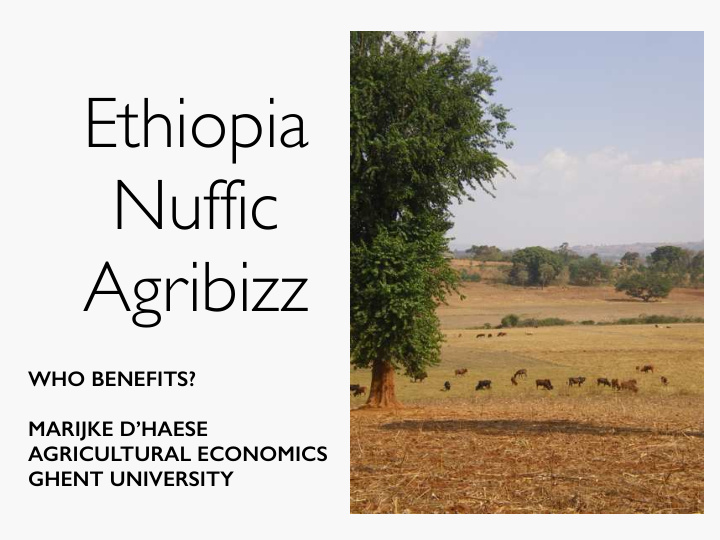



Ethiopia Nuffic Agribizz WHO BENEFITS? MARIJKE D’HAESE AGRICULTURAL ECONOMICS GHENT UNIVERSITY ¡
Partners @ Department of Agricultural Economics, Ghent University • Jimma University - College of Agriculture and Veterinary Medicine • Haramaya University - School of Agricultural Economics & Agri-business Management • Ambo University • Hawassa University
! Increasing! supply!chain! High!value! Decommodification!! management!! Speciality! Driven'by' High! markets! domestic' Driven'by' quality! coffee! supermarket' donors,' Intra!and!interDorganizaional!coordination! dairy! NGOs,' chains,' products!! Organic!&! restaurants,' agrifood' fair!trade! hotels' firms'' markets! Domestic! Export! Coffee! markets! markets! !Processed! Local! food!crops!! industrial! Driven'by' Food'security' crops!! international' Weak'drivers,'' !for!import! Spices,! market' philantrocapitalism' substitution! ginger!! institutions'' and'some'donors'' IndustryDled! processing! Traditional! and!value! food!crops!! addition!!! Longstanding! Commodity! production! Low!value! exchanges!! constraints!!! Institutional'development' Market ¡mapping ¡(adapted ¡from ¡Poole ¡& ¡de ¡Frece, ¡2010) ¡
Ongoing @ UGent • Value chain integration and its impact on performance, the case of malt barley value chain in Ethiopia • Efficiency of alternative institutional arrangements in the coffee market in Ethiopia • Comparative analysis of alternative coffee value chains in Southwest Ethiopia; A way forward to enhance competitiveness and income of smallholders
Ongoing@UGent • Market policy reform and the introduction of Ethiopian commodity exchange in directing the Ethiopian coffee market • Biophysical controls on Ethiopian Arabica coffee quality • Proximate composition and minor constituents of Oromo Potato (Plectranthus edulis) as Influenced by storage duration and potentials for value addition
Value Chain Development Collaboration in the value chain Gender aspect
Value Chain Development • Focus on domestic and export chains • Coffee, Barley, Potatoes, Roses, Dairy • Actors? • Small scale producers at the bottom of the market chain • Farm workers • Traders or cooperatives • Unions • ECX • Exporters
Coffee ¡Chain ¡ ¡ (Zekarias)
Value Chain Development Q1: Who benefits? • How can farmers be included in value chains? • How does inclusion affect smallholder/resource poor farmers? • Pathways of change • Outcomes: • Price received • Information and advice • Economic and social wellbeing • Labour conditions • Gender empowerment • Incentives
Value Chain Development • Q2: Why do we ask this question in a context of value chain development? • Equity - fair price to producer or farm worker • Efficiency - food production & transaction costs • Quality - e.g. asymmetric information, sorting and classing • Upscaling and development
Value Chain Development • Inclusive business models Private sector for-profit initiatives which include the poor with the stated intention to improve their well-being through mechanisms going beyond arms’-length market transactions CSR ¡ Corporate ¡Social ¡ Supply ¡ ¡ Farmers Responsibility ¡ Farmers ¡groups ¡ Quality Cooperatives
Value Chain Development • Ethiopian Commodity Exchange • Established 2008 • To bring actors together and overcome information problems • Studies for the coffee sector (Tinsae) • Limited price integration with international markets • Larger but still limited national integration between the coffee producer zones • High quality areas dominate price setting • Yirgachefe and Sidama adapt price more quickly
Value Chain Development • Certification systems - compliance in production • Organic • Fair trade • Industry specific - e.g. flower sector Third ¡party ¡ ¡ Monitoring Large ¡scale ¡ producer Buyer Farmers ¡groups ¡ Farmers Cooperatives Impact ¡but ¡monitoring ¡challenging
Collaboration in Value Chains • Actors - vertical and horizontal links • Small-scale producers in cooperatives, associations • Contracts • Who benefits? • Cooperative members? • Contracting parties?
Collaboration in Value Chains • Coffee cooperatives (Zekarias) • Large heterogeneity between cooperatives and amongst members • Eventual effect is not large • Important side-selling
Gender in value chain • Gender empowerment through inclusion? • Who benefits? Women? • Do female cooperative members have benefits • women’s decision making on expenditure • awareness/knowledge on improved techniques • control over finance • Coffee sectors (Zekarias)- limited effects, yet heterogeneous amongst cooperatives
Value Chain Development Collaboration in the value chain Gender aspect
Recommend
More recommend